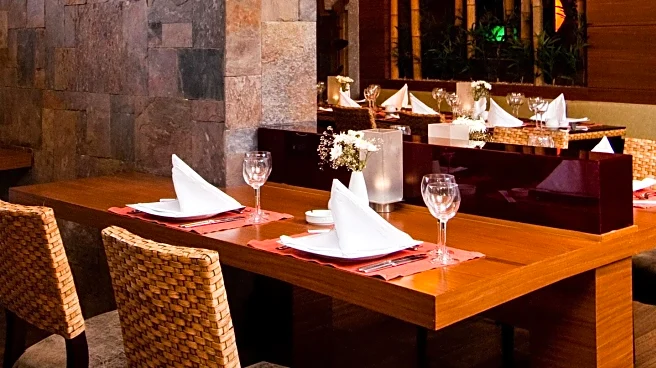What's Happening?
Marriott International has released a report titled 'The Future of Food 2026,' which explores evolving dining preferences and trends across the Asia Pacific region. The report, based on insights from over 30 culinary experts and surveys from 270 Marriott properties,
identifies a shift towards 'fine-casual' dining. This trend involves comfort foods enhanced with high-end culinary techniques, offering a luxurious yet familiar dining experience. The report notes that 59% of Marriott properties have observed increased guest demand for casual dining settings. Additionally, dining is becoming a multisensory experience, with restaurants incorporating interactive elements like dining in the dark and themed environments. The report also highlights a growing emphasis on local ingredients, with 85% of surveyed properties using locally sourced items, supporting local farmers and enriching culinary storytelling.
Why It's Important?
The shift towards comfort-driven luxury and sensory dining in the Asia Pacific region reflects broader changes in global culinary trends. This evolution impacts the hospitality industry by redefining luxury dining as more accessible and experience-focused. The emphasis on local ingredients supports regional economies and promotes sustainable practices. As technology integrates into dining experiences, efficiency and personalization are enhanced, although maintaining a human touch remains crucial. The recognition of Asian culinary hotspots like Indonesia, the Philippines, Vietnam, and China showcases the region's growing influence on the global stage, potentially attracting more international tourism and investment in the hospitality sector.
What's Next?
As the Asia Pacific region continues to embrace these dining trends, restaurants and hotels may further innovate to meet evolving consumer preferences. The integration of technology, such as AI-powered menu engineering, could become more prevalent, enhancing dining personalization. The focus on local ingredients and immersive experiences may lead to collaborations with local producers and artists, enriching the cultural narrative of dining. Additionally, the global recognition of Asian culinary hotspots may encourage more chefs to experiment with traditional and modern techniques, further elevating the region's culinary status.
Beyond the Headlines
The shift towards comfort-driven luxury dining in the Asia Pacific region may influence ethical and cultural dimensions in the hospitality industry. By prioritizing local ingredients, the industry supports sustainable practices and celebrates cultural heritage. The integration of technology in dining raises questions about balancing efficiency with human interaction, highlighting the importance of maintaining personal connections in hospitality. As the region gains global culinary recognition, it may inspire other regions to explore their culinary traditions, fostering a diverse and inclusive global food culture.














